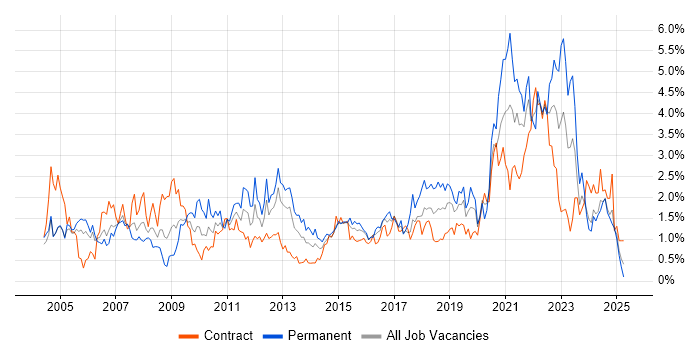Domain Name System (DNS)
Buckinghamshire > Milton Keynes
The table below provides summary statistics and contractor rates for jobs advertised in Milton Keynes requiring DNS skills. It covers contract job vacancies from the 6 months leading up to 7 January 2026, with comparisons to the same periods in the previous two years.
| 6 months to 7 Jan 2026 |
Same period 2025 | Same period 2024 | |
|---|---|---|---|
| Rank | 38 | 36 | 39 |
| Rank change year-on-year | -2 | +3 | +18 |
| Contract jobs citing DNS | 10 | 5 | 14 |
| As % of all contract jobs in Milton Keynes | 2.66% | 1.95% | 2.92% |
| As % of the Communications & Networking category | 29.41% | 12.20% | 14.00% |
| Number of daily rates quoted | 9 | 5 | 13 |
| 10th Percentile | £525 | £416 | £421 |
| 25th Percentile | £560 | £425 | - |
| Median daily rate (50th Percentile) | £625 | £565 | £465 |
| Median % change year-on-year | +10.62% | +21.51% | -15.46% |
| 75th Percentile | £638 | £599 | £465 |
| 90th Percentile | £655 | £618 | £498 |
| Buckinghamshire median daily rate | £613 | £565 | £465 |
| % change year-on-year | +8.41% | +21.51% | -15.46% |
All Communications and Computer Networking Skills
Milton Keynes
DNS falls under the Communications and Computer Networking category. For comparison with the information above, the following table provides summary statistics for all contract job vacancies requiring communications or computer networking skills in Milton Keynes.
| Contract vacancies with a requirement for communications or computer networking skills | 34 | 41 | 100 |
| As % of all contract IT jobs advertised in Milton Keynes | 9.04% | 15.95% | 20.83% |
| Number of daily rates quoted | 24 | 30 | 80 |
| 10th Percentile | £130 | £405 | £320 |
| 25th Percentile | £436 | £491 | £465 |
| Median daily rate (50th Percentile) | £560 | £533 | £550 |
| Median % change year-on-year | +5.16% | -3.18% | +5.77% |
| 75th Percentile | £608 | £621 | £650 |
| 90th Percentile | £650 | £633 | £825 |
| Buckinghamshire median daily rate | £550 | £525 | £550 |
| % change year-on-year | +4.76% | -4.55% | +4.76% |
| Number of hourly rates quoted | 1 | 0 | 7 |
| 10th Percentile | - | - | £23.85 |
| 25th Percentile | - | - | - |
| Median hourly rate | £36.00 | - | £24.00 |
| 75th Percentile | - | - | £30.00 |
| 90th Percentile | - | - | - |
| Buckinghamshire median hourly rate | £36.00 | - | £24.00 |
| % change year-on-year | - | - | +41.18% |
DNS
Job Vacancy Trend in Milton Keynes
Historical trend showing the proportion of contract IT job postings citing DNS relative to all contract IT jobs advertised in Milton Keynes.

DNS
Daily Rate Trend in Milton Keynes
Contractor daily rate distribution trend for jobs in Milton Keynes citing DNS.

DNS
Hourly Rate Trend in Milton Keynes
Contractor hourly rate distribution trend for jobs in Milton Keynes citing DNS.

DNS
Co-Occurring Skills & Capabilities in Milton Keynes by Category
The following tables expand on the one above by listing co-occurrences grouped by category. They cover the same employment type, locality and period, with up to 20 co-occurrences shown in each category:
